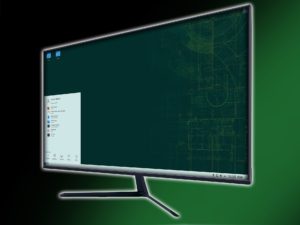I like old ThinkPads. A lot. Maybe it’s the spartan and utilitarian flat, black-on-black, squared-corner design that says, if a laptop could talk, ‘my laptop can beat up your laptop, and leave a nasty dent in its shiny shell.’ Maybe it’s the titanium frame found in some of the models, including my daily driver(s), a T60 and an X61s. But I’m not a fan of the new ones. In fact, it’s been decades since I’ve had a ‘new’ ThinkPad. I like the old ones, and haven’t even bothered trying a new one. But Windows won’t run well on these things anymore, and that’s okay. I’m a Linux guy anyway.
My first business was started on an HP tower of some sort, an unremarkable thing that I had overclocked to a blazing 384 mhz and which has long since been abandoned. I probably took it apart and left it that way, like any self-respecting computer guy might do. Prior to that I was using ThinkPad 600’s, all pre-owned, but nearly indestructible. The HP tower was eventually replaced by this ThinkPad G40 on which I am writing this article now. If I felt inclined to blow the protective layer of dust off it, the G40 would still look new, with not even a scratch, after 15 years.
The Thinkpad G40, while not the cheapest computer available at the time, was built to meet a price point. Even a decade and a half ago, with a 2.4Ghz single core Pentium 4 (desktop) processor, and a scant 512MB of RAM, the ThinkPad G40 was solidly a mid-market machine. The hard drive has been upgraded to 40GB. Yes, that’s all. By today’s standards, this computer is worthless to most people, but Linux people are a special breed. Still, for most others, it’s of questionable value. It can’t run the latest windows versions, unless you are a very patient person, or unless you don’t mind going out for ice cream every time you give it complicated task to do, like open Google Chrome while you have your Thunderbird open as well.
I had set up the G40 as a web server, running Debian Base and sitting quietly in the den upstairs holding my development websites. Once the sites were live, I didn’t really need it as a testing server anymore, but it seemed a shame to put it in a closet somewhere. It wanted to live, to work, to write, to share.
For those mad scientists out there, the larger, more full-featured Linux desktop environments, like Gnome 3, will not run on a machine with these specifications. I have tried, and I have failed, so that you don’t have to. A full desktop environment may or may not boot. Even if it does boot, booting is not the same as ‘running’.
The Mate desktop, reminiscent of the old Gnome 2 desktop, was simply okay in terms of performance on a low-spec machine, but I still gained a few pounds going out for ice cream whenever I gave the G40 something to do. A simpler and lighter solution was in order.
I’ve run LXDE on this machine before, but even as lightweight as LXDE can be, it was slow to navigate, and very, very ugly. I felt like I had to sneak up my G40 for fear of turning to stone. Anyone who has ever used LXDE without massive customization knows exactly what I mean.
LXDE uses Openbox as its window manager. I’ve used Openbox before with Arch Linux and with Manjaro on other machines. The setup of using just Openbox as opposed to a full desktop is definitely lightweight and easy on RAM. However, it’s fiddly. Nothing is easy to navigate. Apps are hard to find. They’re all filed away somewhere forgotten. Openbox is a setup best suited for those with a better memory than mine. Navigation is accomplished most efficiently by keyboard shortcuts, all of which need to be memorized.
There is also a simple menu available for Openbox. Installing the menu package from Debian’s repository will give menu access to installed apps. [sudo apt-get install menu].
Minimal design is fine, and even preferable, but I want all my stuff within reach by a number of ways, including via keyboard shortcuts, if I choose, and if I happen to remember what the shortcuts are that particular day.
In the end, I found Bunsenlabs which is the continuation of the CrunchBang project. I’m not making these names up. Based on Openbox and Debian Stable, Bunsenlabs is light, and it’s fast, and it’s actually quite pretty, but still in need of a launcher to quickly find apps and files. An app called Synapse, available from Debian Backports, did the trick. CTRL-Space and I have a nifty box into which I can type the name of an app or a file, even if I can only remember part of the name. It’s a suitable best-guessers app. I even can type swear words into the box if I can’t find what I want, some obscurely named file which defies location, and Synapse doesn’t mind my profanity at all. In fact, when typing swear words into Synapse, I sometimes even find some some files I’d forgotten to delete.
If I don’t have Dropbox running, the Bunsenlabs/Debian desktop boots in about 100MB, and stays there, being lovely and frugal. A friend of mine implored me to buy something newer instead of fiddling with old laptops, trying to make lemonade from silicon lemons. She insisted that old things will only break, often reminding me of old things I’d bought that had indeed broken. Bah, I say. Viva la Thinkpad! Long live the kingdom of the black brick.

